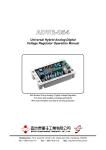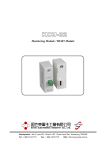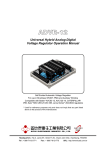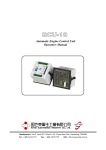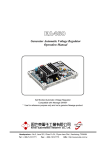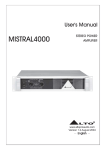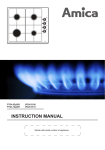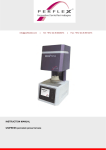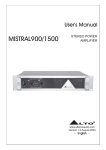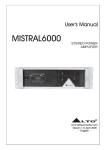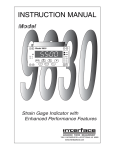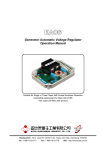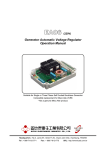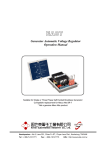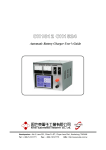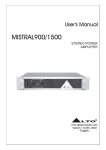Download EA63-4 - Kutai Electronics
Transcript
EA63-4 Generator Automatic Voltage Regulator Operation Manual Self Excited Automatic Voltage Regulator Compatible with Basler AVC63-4A* * Use for reference purpose only and not a genuine Basler product. Headquarters : No.3, Lane 201, Chien Fu ST., Chyan Jenn Dist., Kaohsiung, TAIWAN Tel : + 886-7-8121771 Fax : + 886-7-8121775 URL : http://www.kutai.com.tw 1. SPECIFICATION Sensing Input Voltage Frequency Power Input Voltage Frequency Output Voltage Current Resistance 1 phase 95 ~ 139 VAC ±10% or 190 ~ 277 VAC ±10% 50 / 60 Hz, selectable 95 ~ 139 VAC ± 10%, 1 phase2 wire 50 / 60 Hz Max. 63 VDC Continuous 4A Intermittent 7A for 60 sec 9A for 10 sec Min. 15 ohm Max. 100 ohm Voltage Regulation < ± 1% ( with 4% engine governing ) Voltage Build-up Residual voltage at AVR terminal > 5 VAC Thermal Drift 0.05% per °C change in AVR ambient External Volts Adjustment ± 15% with 10K ohm 1 watt trimmer EMI Suppression Internal electromagnetic interference filtering Unit Power Dissipation Max. 15 watt Under Frequency Protection (Factory Setting) Knee point adjustable range 45 ~ 55 Hz Over Excitation Shutdown Field volts shut down after a time delay If exciter field volts exceed 95 VDC ± 5% Dimensions 140mm L * 125mm W * 48mm H Weight 280g ± 2% V/Hz “CORNER FREQUENCY” SELECTION AND ADJUSTMENT For 60 Hz systems, the regulator is preset at the factory for a 55 Hz “corner frequency”. For 50 Hz systems, a 45 Hz “corner frequency” is achieved by connecting a jumper across terminals Hz1 and Hz2. The corner frequency can be adjusted by the U/F ADJ rheostat on the AVR. Clockwise rotation results in raising the corner frequency (shitting the curve to the right). To set the UF rheostat : 1. Adjuat the UF Rheostat fully CCW. 2. Start the generator and set at rated voltage. 3. Adjust the generator frequency to the desired kneepoint frequency. Frequency Compensation Curves Figure 1 4. Slowly adjust the U/F ADJ rheostat clockwise (CW) until the generator voltage just begins to decrease. 150 140 TIME DELAY (SECONDS) 130 120 110 100 OVEREXCITATION SHUTDOWN 90 80 70 60 50 40 30 20 10 0 80 85 90 95 100 105 110 115 120 125 130 135 140 145 150 155 160 165 170 Overexcitation shutdown is included that removes the output power if the exciter field voltage exceeds 95 Vdc. If exciter field voltage exceeds 95 Vdc ± 5%, the regulator automatically removes field current, after a time delay. The time delay is inversely proportional to the magnitude of the detected overvoltage condition. At 134 Vdc, the field voltage is removed after approximately 10 seconds. Refer to the following figure. EXCITER FIELD VOLTAGE (VOLTS) After output power is removed, the regulator can be reset by decreasing the input voltage to less than 6 Vac for a minimum of 2 Typical Time Delay Characteristic Curve seconds; this may be accomplished by stopping the prime mover or by Figure 2 interrupting the regulator input with a reset switch. ______________________________________________________________________________________ 2 EA63-4 2. OPERATION PROCEDURE SWITCH INITIAL SETTING 2.1 STABILITY ADJUST RHEOSTAT (STAB) Regulator VAR Fully CCW ● An internal screwdriver adjustable potentiometer provides adjustment to the response rate of the generator output voltage to a change in load. Remote VAR Centered 2.4 SYSTEM STAR-UP ● Clockwise rotation of this adjustment provides an increase in the response time and therefore decreases the amount of voltage overshoot (increased stability).Counter-clockwise rotation of this adjustment provides a decrease in the response time (faster response time) and therefore increases the amount of voltage overshoot (decreased stability). 1. Perform preliminary set-up as described in the above paragraphs. 2.2 OPERATION RESULT : The following system operation procedures provide instructions for adjusting the EA63-4 voltage regulator. Symptoms resulting from a faulty regulator and certain generator system problems are included, together with suggested remedies. Voltage should build up. If not, perform Field Flashing. CAUTION ! Meggers and high potential test equipment must not be used. Incorrect use of such equipment could damage the semiconductors contained in the regulator. 2.3 PRELIMINART SET-UP 1. Verify that the voltage regulator specifications conform with the generator system requirements. 2. Ensure that the regulator wires are as follows: ● If the remote voltage adjust rheostat is not to be connected, ensure terminals 6 and 7 are shorted with a jumper. ● If a 55 Hz “corner frequency” for 60 Hz systems is desired, ensure that the HZ1 and HZ2 terminals are open. If a 45 Hz “corner frequency” for 50 Hz systems is terminals are shorted together with a jumper. ● For 120V nominal sensing, ensure that terminals V1 and V2 are not connected. For 240V sensing, ensure that terminals V1 and V2 are connected together. 3. Ensure the voltage regulator is connected to the generator system. correctly 4. Install the fuses as described in Fuses. NOTE : All voltage readings are to be taken with an average reading voltmeter. 2. Start prime mover and bring up to rated speed. 3. Slowly adjust the regulator VAR CW until the generator output voltage reaches the nominal value. If used, adjust the remote VAR to set the generator voltage to the exact value desired. RESULT: Voltage should build up to rated value. If voltage does not build up to rated value, check generator for short or excessive load. 4. Check regulator normal operating and loading conditions. RESULT: Voltage regulation should be better than ±1.0% no-load to full-load. If regulation is not within this range, perform the following steps: ● Voltage reduction under load may be due to speed change from no load to full load. causing the frequency compensation (U/F) circuit to reduce voltage at lower frequencies. ● Replace voltage regulator. 2.5 OPERATIONAL TEST 1. Connect the test setup as shown in the following figure, Operational Test. Do not apply power. Ensure that the light bulb is rated for 120V and is less that 100W. Complete the following steps before proceeding with the system start-up. 5. Set the regulator VAR and external VAR (if used) as follows: ______________________________________________________________________________________ EA63-4 3 2. Adjust the regulator VAR and/or remote VAR, and the STABILITY Adjust to maximum CCW. The following notes () apply to the interconnection diagrams: 3. Apply 120V, 50/60 Hz power to the regulator. 1. If external pot is not used, short terminals 6 and 7. The light bulb should illuminate. 4. Slowly adjust the regulator VAR control CW. At the regulation point, the light bulb should extinquish. Small adjustments above and below this level should cause the light bulb goes on and off rapidly. 5. Rotate the STABILITY ADJ fully CW. Now adjust the regulator VAR above and below the regulation point. The light bulb should still to off and on, but the transition from off to on (and vice versa) should be much slower than in the paragraph above. 2. For 50Hz, short terminals HZ1 and HZ2 and leave open for 60Hz. 3. Item not supplied by KUTAI ELECTRONICS. 4. For 120V Nominal sensing, make no connection to terminals V1 and V2. For 240V Nominal sensing, short terminals V1 and V2 together. 5. Select fuses with high interrupting capacity. 3 1 7 EXCITATION ON-OFF SWTCH (IF USED) 1 4 R 4 10 12 9 6 R 7 N 5 11 S 2 N 10 T S 11 8 12 3 T 8 9 5 6 2 3 EXTERNAL VOLT.ADJ. RHEOSTAT 10K 1W 3 EXC. FIELD 5 4 3 F+ F- EXC. FIELD 3 2 6 4 E3 V1 V2 E1 EXTERNAL VOLT.ADJ. RHEOSTAT 10K 1W 3 1 7 F+ F- 1 5 4 3 E3 V1 V2 E1 4 EA63-4 3 2 6 7 EA63-4 Interconnection Diagram, 127 / 220 V Nominal, 3-phase, 4-Wire Interconnection Diagram, 277 / 480 V Nominal, 3-phase, 4-Wire Figure 4 Figure 5 3 EXCITATION ON-OFF SWTCH (IF USED) EXTERNAL VOLT.ADJ. RHEOSTAT 10K 1W T N FIELD S EXTERNAL VOLT.ADJ. RHEOSTAT 10K 1W 3 EXC. FIELD 4 3 2 F+ F- 3 4 3 3 1 5 F+ F- 1 2 3 E3 V1 V2 E1 EXCITATION 0N-OFF SWITCH (IF USED) 6 7 EA63-4 4 E3 V1 V2 E1 3 6 7 EA63-4 NOTE : IF GLASE TYPE FUSE IS USED 3 ENCLOSE FOR SAFETY Interconnection Diagram, 127 / 220 V Nominal, 1-phase, 3-Wire Operational Test Figure 6 Figure 7 ______________________________________________________________________________________ 4 EA63-4




